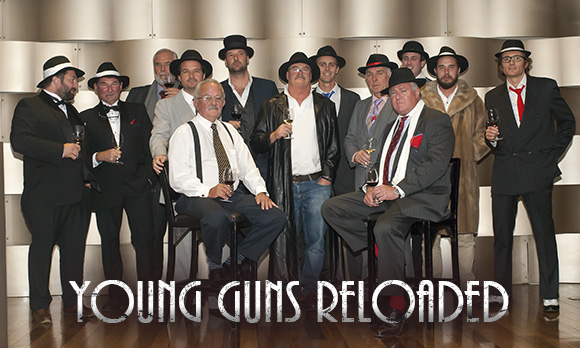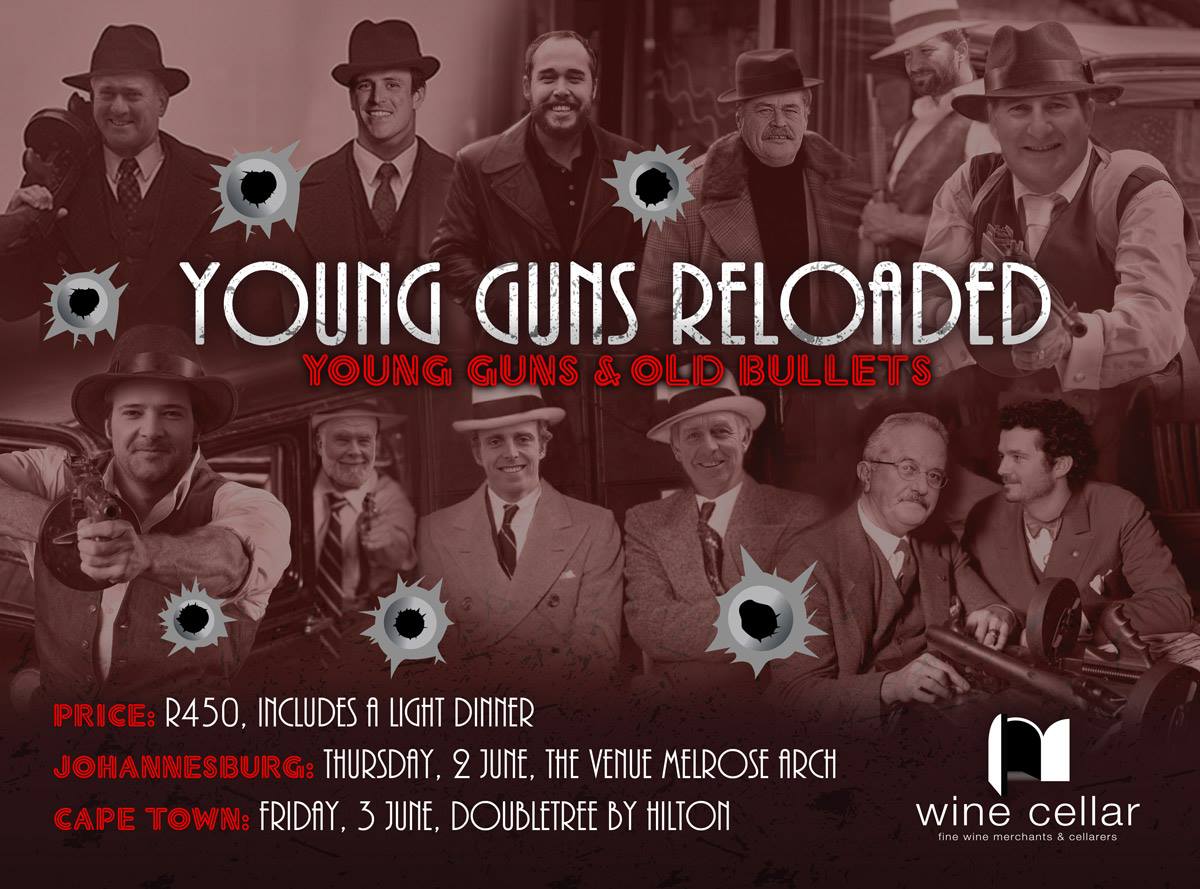Fathers and Sons

There can be few scenarios that better illustrate the immense changes that have taken place in the South African wine industry over the past decades than a presentation of their wines by a father and his son – in just one generation we have seen a paradigm shift.
Six such father-and-son pairings were assembled by Wine Cellar’s Roland Peens for the sixth annual Young Guns event (this year titled Young Guns & Old Bullets). Each father and son provided fascinating reminiscences of the past and intriguing glimpses into the future respectively for the 200-plus enthusiastic audience.
Peter Finlayson (Bouchard Finlayson) and Peter-Allan Finlayson (Crystallum) got the evening off to a fine start, each presenting a Pinot Noir, a variety indelibly associated with the Finlayson name. Finlayson senior reminded how, when he and Tim Hamilton Russell started the eponymous vineyards in the Hemel-en-Aarde Valley in the 1970s, the KWV-regulated quota system, which determined where wine grapes could be grown, was still in force. One of the two farms Hamilton Russell purchased had no quota. To throw inspectors off the scent of the Chardonnay and Pinot Noir planted there, the team dumped fruit from several of the outside rows. Believing there was no irregularity the inspectors left, allowing Finlayson to harvest and vinify the rest of the fruit. The rest is history, with the valley now firmly established as producing Chardonnay and Pinot Noir of high quality. Finlayson set up his own shop next door to Hamilton Russell Vineyards in 1989, after winning the Diners Club Winemaker of the Year award, for which Burgundian Paul Bouchard was the international judge. The pair joined forces in Bouchard Finlayson, marking one of the earliest international investments in South African wine. Finlayson poured his dark-fruited Bouchard Finlayson Galpin Peak Pinot Noir 2012.
The quota system long gone (it was dropped in 1992), the search has been on for new areas, especially for cool-loving varieties. Unable to go further south, today all eyes are turned upwards, and altitude is proving to be the right call. What is now the ward of Elandskloof, near Villiersdorp, was once home to High Noon, a game park owned by the Ovenstones. Today its vineyards, planted with much better vine material, produce highly regarded wines from well-known sites such as Kaaimansgat and, for the past four vintages, Finlayson junior’s Mabalel Pinot Noir. The vines are still young but the yet-to-be released Crystallum 2015 shows the huge potential of the area. It was my young wine of the evening. And to think the young Finlayson studied philosophy and economics when trying to break away from the family winemaking habit – thank goodness he didn’t resist for too long!
Danie (senior) and Danie (junior) Steytler – there’s even an infant winemaker Danie waiting in the wings: “We like to keep things simple on Kaapzicht,” confirmed Danie senior – brought their story full circle. When he started farming, Danie senior supplied wholesalers but always wanted to bottle his own wine. So as not to tread on their toes and lose their valuable customers (competition wasn’t appreciated), Danie planted Riesling. Kaapzicht Weisser Riesling 1984 was the first wine available to the public. Their vineyards were then dominated by white varieties. The first red was from Cinsaut: “The poor man’s Pinot,” said Danie senior, who prefers his favourite big Cabernets and Pinotages. After much persuasion from Danie junior, his Dad relented and was happy to show us his new Kaapzicht Cinsaut 2015, while Danie senior chose Pentagon 2007, a big Cabernet-Merlot blend.
Jacques and Reenen Borman are confirmed Syrahphiles, so no surprise they both chose a Syrah: Jacques Boschkloof Syrah 2005, Reenen Boschkloof Epilogue 2014. In Borman senior’s day, there was no such designation as a single vineyard, indeed it was illegal to put it on a label. Estate was then the smallest Wine of Origin, a regulation jealously guarded by the Estates’ Association. That hindrance too fell in 2004 and Borman junior’s quest now is to vinify distinctive vineyards. His Boschkloof Epilogue 2014 is from one such single vineyard in the Stellenbosch Hills, whereas his father’s Boschkloof 2005 comes from homegrown vineyards. As for the rigorous life of a winemaker? “It’s the only job where you can go home and the wife won’t ask where you’ve been,” joked the younger Borman.
Christo le Riche, Etienne’s son, is following the same path of site selection with Cabernet Sauvignon. “The variety synonymous with Stellenbosch,” claimed the younger Le Riche, “but understanding its full diversity needs many more years.”
Le Riche Cabernet Sauvignon Reserve 2013 is youthfully fine. One can but hope that this and other vintages will mature as well as Etienne’s Le Riche CWG Auction Reserve 2005, as fine an older South African Cabernet as I’ve tasted. The younger Le Riche, with his sister, Yvonne, is also exploring the Cabernet Sauvignon and Cinsaut blend that his father made famous at Rustenberg in the 1970s and 80s. As at Kaapzicht, the wheel is turning full circle.
Quiet streams run deep – well the saying goes something like that and it well applies to the Van Velden family, with seven generations on the Stellenboschkloof farm, Overgaauw. They have notched up several firsts: the first Sylvaner, the only one in the Cape, and the first Merlot on the market. Leaders too in other ways: among the earliest to use small French oak barrels and to release a blend of Bordeaux varieties called Tria Corda, they were also pioneers of many Portuguese varieties and usually have the oldest Cape Vintage available on the market. There was never a question that young David would follow his father, Braam, in the cellar: as a very young fellow he could be found in the cellar asking to taste with his father. Refinement rather than reinvention sums up what’s going on at Overgaauw, as David’s Tria Corda 2013 and Braam’s still very much alive Tria Corda 1998 proved. Alive also describes the Old Bullets generally or, as Van Velden senior puts it, SOSs – slower, older but so much smarter!
Neil and Warren Ellis were last on stage. As Groot Constantia’s winemaker in the 1970s, Ellis senior experienced the red wine boom, when wine lovers (myself included) queued to buy some of the Cabernet, Shiraz and Pinotage on sale one Wednesday a month. Realising no single piece of land can be good for all grape varieties, he also led the field in the 1980s as a negociant: “Where the winery is located is irrelevant, the fruit source is most important,” Ellis explained. A view also held by Ellis junior. Both agreed with the Le Riche view of a diverse Stellenbosch: “It can’t be blanketed.” They both chose to show the Jonkershoek-sourced Neil Ellis Vineyard Selection Cabernet Sauvignon from 2013 and 2000, similar in their classic Cab structure and ageability.
All these fathers and sons paid tribute to and acknowledged what each learns from the other. I’m sure Peens is already thinking of a theme for the 2017 edition of this perennial favourite event. In the not too distant future one hopes he could put on a Mothers and Daughters (or Sons) Young Guns.

– Angela Lloyd